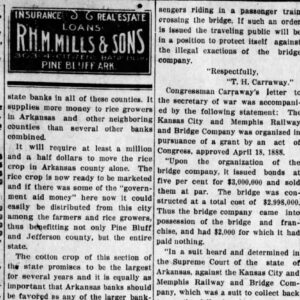calsfoundation@cals.org
Kansas City and Memphis Railway
The Kansas City and Memphis Railway Company (KC&M) at its brief peak in 1914 was the largest non-Frisco (St. Louis–San Francisco Railway) railroad in northwestern Arkansas, with 63.97 miles of standard gauge track. The railroad, based in Rogers (Benton County), was formed in 1910. It absorbed the Arkansas and Oklahoma Western Railroad, which ran from Rogers to Siloam Springs (Benton County), and the Monte Ne Railway, which ran from Monte Ne (Benton County) to Lowell (Benton County), in 1911. The business plan projected a western terminus of Wagoner, Oklahoma, and an eastern extension that would serve Huntsville (Madison County) and Little Rock (Pulaski County) en route to Memphis, Tennessee. The railroad was backed by prominent Rogers banker William R. Felker.
The twelve-mile segment between Tontitown (Washington County) and Fayetteville (Washington County) opened in August 1912. The KC&M route between Cave Springs (Benton County) and Fayetteville largely duplicated the established Frisco Central Division main line between Rogers and Fayetteville. The small communities on the extension—Elm Springs (Washington and Benton counties), Tontitown, Steele (Washington County), Litteral (Washington County), and Mount Comfort (Washington County)—generated little business except seasonal strawberry traffic. The railroad also built, in about 1914, an isolated 1.96-mile extension near War Eagle (Benton County) that connected to a five-mile track owned by the Felker-controlled Ozark Land and Lumber Company east of Monte Ne. The Ozark Land and Lumber track, which included a two-span steel bridge across the White River, in turn connected to the KC&M at Monte Ne.
The railroad at its peak in 1914 owned five locomotives (including one purchased new), fifteen boxcars, and five passenger cars. Some of the locomotives were gradually sold off after 1914 to pay delinquent taxes. In early 1913, the railroad took delivery of a battery-powered car for Rogers to Siloam Springs passenger service. The car, using batteries invented by Thomas A. Edison, seemed to offer low-cost passenger service. The manufacturer promised that the car would operate 120 miles on a single charge, the equivalent of nearly two round trips between Rogers and Siloam Springs, while maintaining a speed of thirty miles per hour. The car performed well between Rogers and Siloam Springs, as the run was mainly downhill. However, the return trip had substantial grades near the community of Highfill (Benton County). The inadequate batteries lacked power to overcome the grades. The battery car was removed from service in mid-1914.
The KC&M, called the “Fruit Belt Line,” relied on apple traffic from the area near Highfill on the Rogers to Siloam Springs main line, and traffic interchanged with friendly connection Kansas City Southern Railway at Siloam Springs. Limited apple traffic was likely the reason the KC&M unwisely decided to build to Fayetteville. However, the Frisco fought fiercely to preserve its freight business in the Washington County seat of Fayetteville (population 4,471 in 1910). Seventeen of the eighteen Fayetteville businesses with rail sidings were served solely by the Frisco. The KC&M could not obtain Fayetteville freight traffic business unless it absorbed the cost of drayage to and from the customers. In addition, the KC&M’s Fayetteville terminal was more than twelve blocks from the principal business district. In 1917, the KC&M petitioned the Interstate Commerce Commission (ICC) to require the Frisco to provide switching services so that Fayetteville customers on Frisco sidings could have their shipments transferred to the KC&M. The ICC denied the KC&M request.
The finances of the KC&M had begun to deteriorate in 1911. Felker, the principal shareholder, kept the railroad in seemingly good health by secretly paying many expenses on behalf of the railroad while it negotiated to sell bonds to finance the Fayetteville extension. The KC&M recorded its last profit in 1913. In July 1914, the Federal District Court in Fort Smith (Sebastian County) placed the railroad in receivership because it could not meet its financial obligations. Bonds issued to finance the Fayetteville extension were a major factor in the road’s financial distress. Debt restructuring efforts failed over the next three years. The two bondholder groups were never able to agree on restructuring the heavy debt burden.
In 1918, a brief glimmer of hope appeared when the United States Railroad Administration (USRA), a federal entity that took over nearly all U.S. railroads to better move soldiers and supplies during World War I, was asked to take over the KC&M. The USRA examined the property informally and indicated that it might take over the railroad except for the line between Cave Springs and Fayetteville. This was unacceptable to the bondholders who had financed the Fayetteville extension. Pursuant to Federal District Court orders, freight and passenger service on the Fayetteville extension ended in March 1918, followed by the Rogers to Siloam Springs line in October 1918. Freight service on the former Monte Ne Railway and the extension continued until early 1919. Removal of the KC&M track began in 1919.
For additional information:
History of Tontitown, the Gem of the Ozarks in the Center of the Great Southwest. Rogers, AR: Kansas City & Memphis Railway Company, 1912.
Kansas City & Memphis Railway Co. Report to the Stockholders for the Year Ended June 30, 1912. Rogers, AR: 1912
“Kansas City & Memphis Railway et al. v. St. Louis & San Francisco Railroad Company et al.” In ICC Reports Vol. 46. Washington DC: Government Printing Office, 1918.
Moody, John. Moody’s Analyses of Investments—Steam Railroads. New York: Moody’s Investors Service, 1917.
Records Group 21, Records of District Courts, Fort Smith Equity Case 245, Boxes 18, 19. National Archives and Record Administration, Fort Worth, Texas.
“Train Service on Extension.” Rogers Democrat, August 22, 1912, p. 1.
Thomas S. Duggan
Lowell, Arkansas
 Early Twentieth Century, 1901 through 1940
Early Twentieth Century, 1901 through 1940 Transportation
Transportation Bridge Tolls
Bridge Tolls 




Comments
No comments on this entry yet.